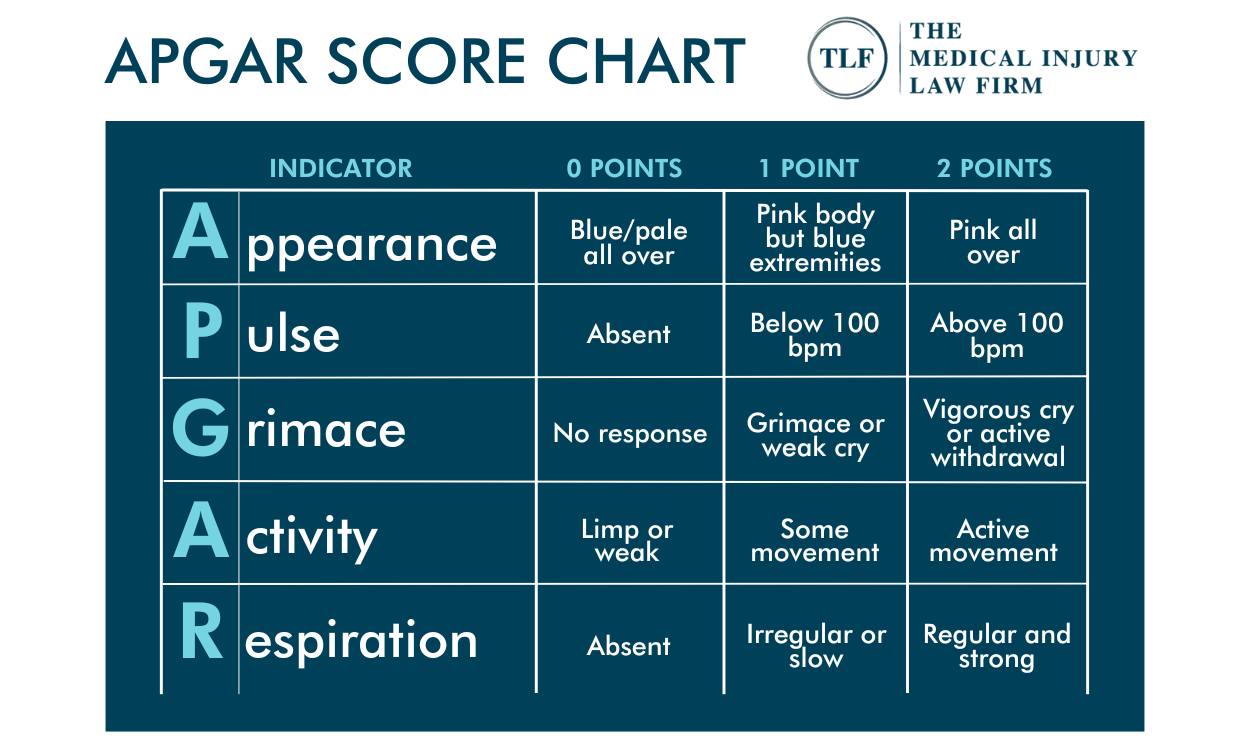In the moments after a baby is born, there are a lot of things that doctors and nurses need to do in order to ensure the baby is healthy. One thing they often do is assign the infant’s Apgar score, which helps determine the baby’s immediate well-being following birth. Higher Apgar scores indicate that the baby is doing well, while lower Apgar scores may mean that the baby needs to be monitored or is in need of immediate medical attention.
While a low Apgar score can be alarming for parents, it’s crucial to understand its implications and potential impact on a child’s development. Below, we’ll explain how Apgar scores are determined, what your child’s Apgar score may indicate, and what legal steps you may need to take following your child’s low Apgar score.
If your newborn infant received a low Apgar score at birth and you believe it was the result of medical negligence, you may be able to seek financial compensation through a medical malpractice lawsuit. The Northern Kentucky and Ohio birth injury lawyers at TLF: The Medical Injury Law Firm can evaluate your situation and determine your eligibility to file a lawsuit. We’re proud to provide guidance and support to families affected by birth injuries in the Cincinnati and Covington areas. Contact us today for a free consultation to learn more about your legal options and how we can help you seek justice for your child.
To schedule a free consultation with a member of our legal team, you can call our Ohio office at (513) 643-1689, our Kentucky office at (859) 898-2472, or toll-free at (800) 698-4054. You can also send us a message online.
What is an Apgar Score?
The Apgar score is a quick and simple assessment tool used in obstetric practice to evaluate the health of newborns shortly after birth. Named after Dr. Virginia Apgar, who developed it in the 1950s, the test is typically administered at one minute and five minutes after birth. The 1 minute test can help determine how well the infant tolerated the birthing process. The 5 minute test can help determine how well the baby is doing outside of the womb.
The Apgar score consists of five criteria:
- Appearance (skin color)
- Pulse (heart rate)
- Grimace (reflex irritability)
- Activity (muscle tone)
- Respiration (breathing rate and effort)
Each criterion is scored from 0 to 2, with a maximum total score of 10. The test is performed by a healthcare provider, usually a nurse or midwife, and is conducted on newborns to assess their well-being and determine if they need any immediate medical intervention, like resuscitation.
Even if the newborn infant has a low score at 1 minute, they will likely improve within the first 5 minutes after birth. If the infant has a 5 min Apgar score lower than 7, however, the infant needs to be monitored and may be re-tested until they reach a score of 7.
Criteria Assessed in Apgar Scoring System
The Apgar test assesses newborns based on five criteria: appearance, pulse, grimace, activity, and respiration. Below are explanations of each of these criteria and how they are scored.
Appearance (Color)
In the Apgar scoring system, the “appearance” assessment focuses on the newborn’s skin color. If the infant appears blue or pale all over their body, they’ll receive a 0. If the infant is pink, but their extremities are blue, they’ll receive a 1. If their entire body is pink, they’ll receive a 2.
It’s rare for a child to receive a 1 min Apgar score of 10, since most newborns still have blue extremities for a while after birth.
Pulse (Heart Rate)
The pulse criterion evaluates the newborn’s heart rate. A score of 0 indicates no heart rate, a score of 1 indicates that the heart rate is below 100 beats per minute, and a score of 2 indicates that the heart rate is above 100 beats per minute.
Grimace (Reflex Irritability)
Grimace, or reflex irritability, refers to the baby’s response to stimulation, such as a gentle pinch. A score of 0 is assigned if there is no response, 1 if there is a grimace or weak cry, and 2 if there is a vigorous cry or active withdrawal.
Activity (Muscle Tone)
The activity criterion assesses the newborn’s muscle tone or activity level. If they have limp or flaccid muscles, they’ll receive a score of 0. If they are able to somewhat bend and move their arms and legs, they’ll receive a 1. If they display active movement and resistance, they’ll receive a 2.
Respiration (Breathing)
The last factor that affects an infant’s Apgar score is their respiration, or their breathing rate. A score of 0 is given if there is no breathing, 1 if the breathing is slow or irregular, and 2 if the breathing is strong and regular.
Why is the Apgar Score Important?
The Apgar score is crucial because it provides a quick and objective assessment of a newborn’s overall health and adaptation to life outside the womb. It helps healthcare providers identify infants who may need immediate medical attention or intervention. Additionally, the Apgar score serves as a baseline for monitoring the baby’s progress and response to any necessary medical treatment in the critical moments after birth.
There are a number of different scientific studies that have aimed to link Apgar score to various short-term and long-term outcomes, like neonatal mortality, post-neonatal mortality, and developmental vulnerability. However, things like gestational age (how long the baby was in the womb), maternal medications administered before birth, cognitive function, birth weight, and resuscitation efforts can affect a child’s one minute Apgar score as well as their five minute Apgar score.
What is a Normal Apgar Score?
A normal Apgar score typically ranges from 7 to 10, with a higher 1 and 5 min Apgar scores indicating better overall health and adaptation to birth. An Apgar score of 7 or above at five minutes after birth is generally considered reassuring, suggesting that the newborn is transitioning well to life outside the womb.
However, it’s important to note that a lower score doesn’t necessarily indicate long-term health issues, as the Apgar score is just one factor in assessing a newborn’s well-being. Additionally, normal Apgar scores do not indicate that an infant is perfectly healthy in all aspects.
Apgar Score Chart

How To Determine Apgar Score
An infant’s Apgar score is determined by evaluating the five necessary criteria and scoring the infants reactions on a scale from 0 to 2. These scores are then totaled to provide an overall assessment of the newborn’s health and well-being, with a maximum score of 10. The assessment is typically conducted by a healthcare provider shortly after birth, usually at one minute and five minutes after delivery.
What Does a Low Apgar Score Mean?
A low Apgar score, typically defined as below 7, may indicate potential issues with the newborn’s health or adaptation to life outside the womb. In general, a lower Apgar score suggests that the baby may require immediate medical attention or intervention to address any underlying problems.
Low Apgar scores have been linked to an increased risk of certain conditions like cerebral palsy, a chronic neurologic disability, though it’s important to note that there is no definitive link between lower Apgar scores and long-term health outcomes. Additionally, preterm infants may have compromised Apgar scores, since the Apgar scoring criteria were designed to evaluate full-term infants.
Potential Reasons for Low Apgar Scores
There are a number of health complications and outside factors that could cause a child to have a lower Apgar score. Some of these factors include:
- Birth complications, such as a difficult delivery, umbilical cord issues, or a C-section birth
- Premature birth, which can affect the baby’s ability to breathe and regulate vital functions
- Maternal factors, including maternal illness, maternal age, or infection during pregnancy
- Fetal distress, which may occur if the baby experiences oxygen deprivation during labor
- Congenital abnormalities or birth defects affecting the baby’s physiology
- Maternal anesthesia or medication during labor, which can affect the baby’s responsiveness after birth
- Inadequate prenatal care, like a failure to monitor the infant and/or mother
- Maternal substance abuse during pregnancy, which can have an impact on child developmental health
Correlation Between Low Apgar Scores and Developmental Challenges
There are a number of studies that link low one-minute and five-minute Apgar scores to certain long-term cognitive outcomes and developmental vulnerabilities. Previous studies done on children born in the 70s found that lower Apgar scores (scores lower than 7) had a correlation on the child’s IQ later in life.
Another population-based study from 2001 found that very low five minute Apgar scores (scores ranging from 0 to 3) correlated with higher infant mortality rates and higher risk of cerebral palsy. A 2002 study found that children with five minute Apgar scores less than 3 and neonatal symptoms of encephalopathy (oxygen deprivation) have a higher risk of motor impairments, epilepsy, and developmental delays when compared to children with higher scores and no neonatal symptoms.
It’s important to recognize that Apgar scores have been linked to a number of potential outcomes. For example, a 2019 study from British Columbia correlates moderate and high five minute Apgar scores with certain adverse developmental outcomes at age 5. The takeaway? A low Apgar score does not guarantee a child will have a long-term neurologic disability, nor does a high Apgar score guarantee that the child will not have any cognitive development issues in their life.
The Importance of Early Intervention For Low Agpar Scores
Early intervention for low Apgar scores is crucial, as it allows healthcare providers to promptly address any underlying issues and provide necessary medical support to newborns. By identifying potential problems early on, medical professionals can mitigate any perinatal risk factors to improve outcomes and prevent further complications.
Lower Apgar score values at the one-minute mark often indicate that the child needs immediate health care, like removing fluid from the airway. Additionally, since lower Apgar scores are often linked to developmental vulnerability, early intervention can ensure children with a higher risk of developmental issues can be monitored. This can also help facilitate timely access to specialized care and support services, which are essential for optimizing the long-term health and development of infants with low Apgar scores.
Legal Considerations for Birth Injuries Related to Low Apgar Scores
In some cases, low Apgar scores could be the result of certain birth injuries, which often occur as a result of medical malpractice. There are a number of things that medical professionals can do wrong in the moments before and after a child is born, which could affect their early neonatal symptoms and lower their Apgar score. For example, failing to perform a c-section in a timely manner can lead to complications like birth asphyxia, which could affect their Apgar score. Additionally, failing to properly monitor maternal and infant characteristics can complicate the birthing process, which can affect a child’s Apgar score.
If your child had a low Apgar score as a result of a birth injury, you may be able to file a medical malpractice claim. While a low or decreasing Apgar score isn’t always indicative of malpractice, it may be an indicator that the child failed to meet certain benchmarks immediately after birth.
How the Ohio and Northern Kentucky Birth Injury Attorneys at TLF Can Help
If your child was given a low Apgar score and you suspect your child suffered from a birth injury, the Ohio and Northern Kentucky medical malpractice attorneys at TLF: The Medical Injury Law Firm are here to help. Our lawyers are skilled in navigating complex medical malpractice cases related to birth injuries, including those stemming from low Apgar scores.
Our experienced legal team is dedicated to advocating for these families by providing compassionate support and guidance throughout the legal process. We work tirelessly to investigate the circumstances surrounding the birth, review medical records, consult with medical experts, and pursue justice on behalf of our clients.
Seeking Justice and Maximum Compensation for Birth Injuries
Developmental disabilities can be difficult to manage, often requiring extensive rehabilitation, expensive assistive devices, and medical treatments. That’s why we at TLF are committed to helping parents recover maximum compensation for their child’s birth injury. We advocate fiercely on behalf of our clients, seeking maximum compensation to cover medical expenses, ongoing care, therapy, and other damages resulting from the birth injury. TLF’s compassionate approach ensures that victims and their families receive the support and representation they need to pursue justice and achieve the best possible outcome.

Call TLF: The Medical Injury Law Firm for a Free Consultation Today
At TLF: The Medical Injury Law Firm, we understand how low Apgar scores and development issues correlate with one another, and we also understand how birth injuries can affect a child’s Apgar score. If your child has experienced a low Apgar score and you suspect that medical negligence may have played a role in their birth injury, don’t hesitate to seek legal guidance. Our experienced legal team understands the challenges you and your family may be facing, and we’re here to help.
Let us be your legal advocates–call us toll-free today at (800) 698-4054 or contact us through our website to schedule a free consultation with us regarding your case.

